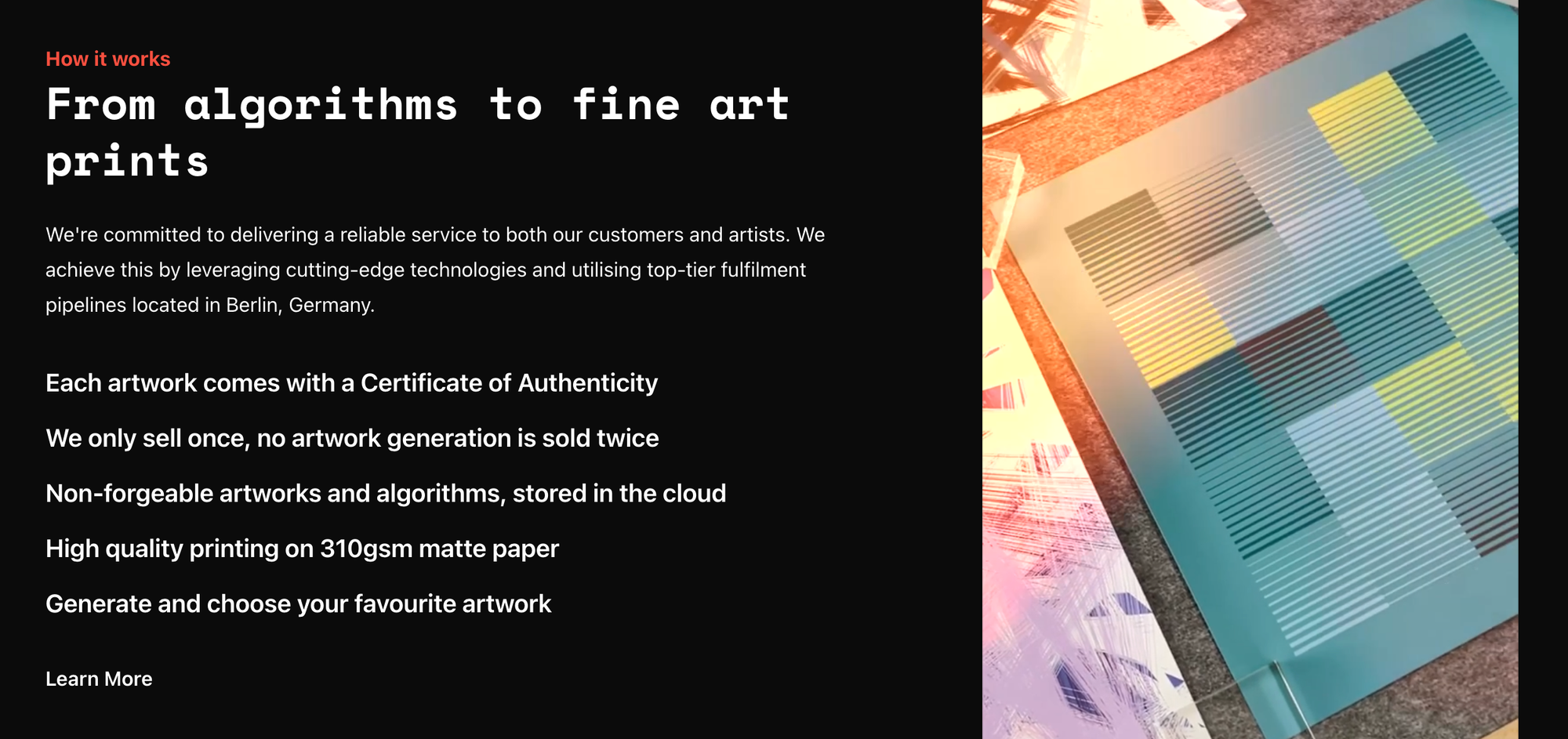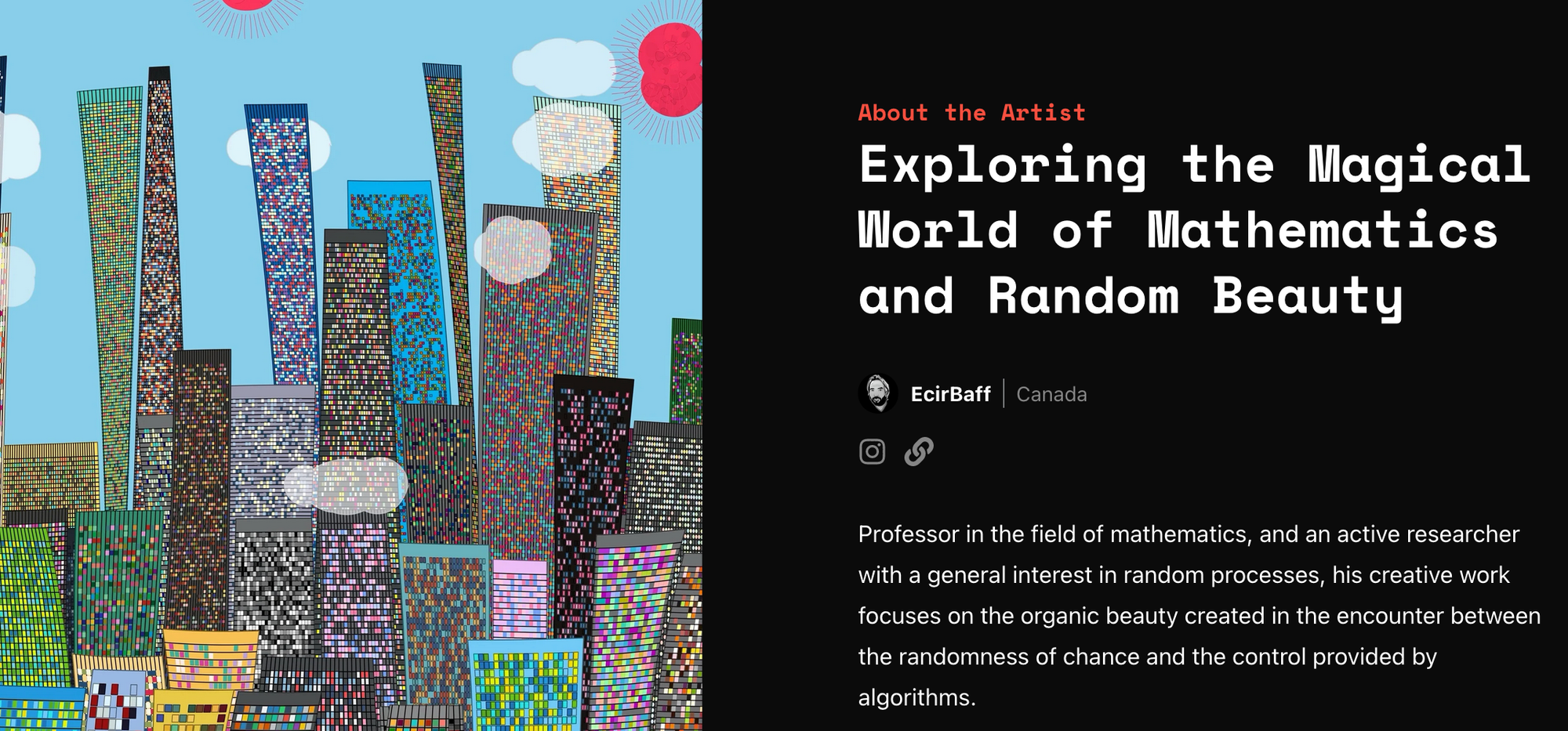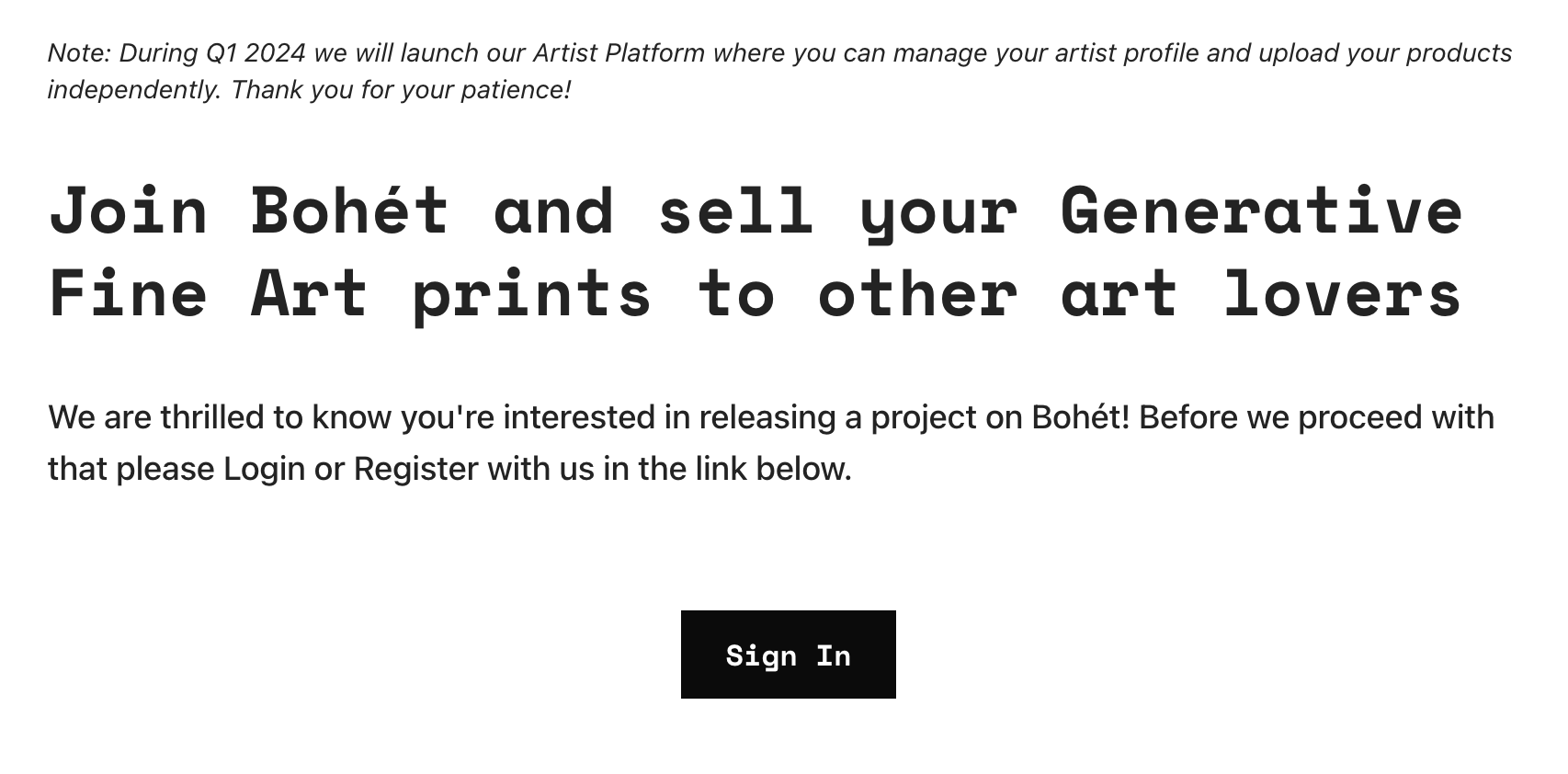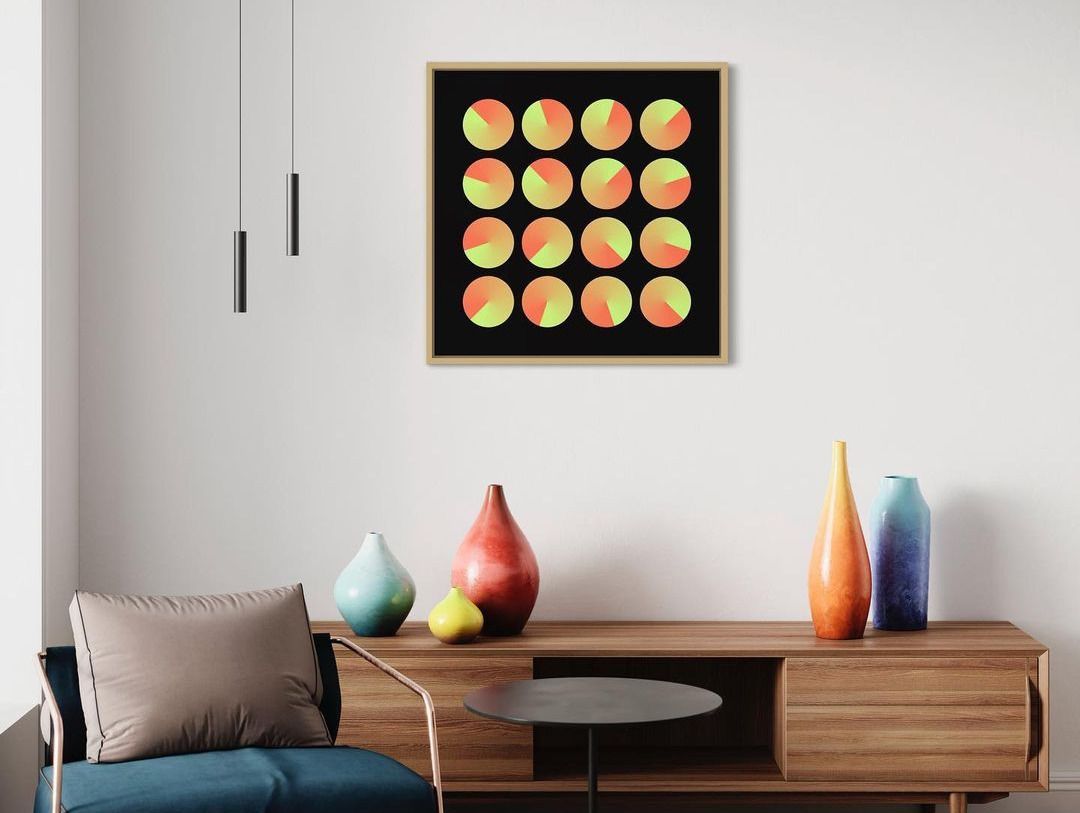Bohét is a young and budding platform, and a first of its kind - it describes itself as a specialized marketplace for generative fine art prints. Created by Nerios Lamaj it aims to streamline the process of distributing generative artworks in the form of physical prints. In this post we have a first look at the platform, and have a chat with Nerios who gives us a peek behind the scenes, telling us about the platform's inner workings.

This article is kindly sponsored by Bohét.
If there's one thing that I want to do on this blog, other than writing about creative coding and generative art, it's to feature cool people that build cool things. In our conversation, Nerios immediately struck me as a down-to-earth kind of guy who's currently in the process of finding a foothold in the generative art space, whilst trying to draw some more eyeballs towards the platform he's built.
I believe that the best way to get to know a platform is by talking to the creators behind it. I quickly asked Nerios for an hour of his time to chat about the platform that he's built, how the idea came to be, and to further explore some of the technical aspects behind the platform. I was also curious about his programming and generative art background. As always, I love learning about the stories of creative people and sharing them with you.
Although this article is sponsored, Nerios specifically asked for an honest and transparent review, and wanted me to write down my honest thoughts on the platform - as I usually would with my writing.
Nerios' Background
Gorilla Sun: For the readers, can you tell us a little bit about yourself; how did you get started with programming and later on generative art, and what do you do these days?
Nerios: Originally I'm from Tirana in Albania, where I grew up. My background mainly lies in computer science and web technologies. Later on I moved to London for my Masters, where I mainly learned about modern technologies like the internet of things, cloud computing and big data. Then in 2020 I relocated to Berlin, where I currently work for various start-ups.
As far as Generative Art goes, that started in February of 2019, when I attended a workshop by Matt DesLauriers at the FITC conference in Amsterdam. That was my very first time learning about creative coding, and the first time that I rendered a canvas element to the browser. I found it incredibly exciting, and it was a pivotal moment for me personally. Ever since, I've tried to dedicate some amount of time to this newfound passion.
GS: Matt DesLauriers makes some awesome stuff, I'm a big fan of him as well. That was right before the pandemic hit in 2020 - did that end up giving you more time to explore creative coding?
NL: Actually, during the pandemic I was in the midst of relocating to Germany, and finding a place in Berlin was difficult [laughs] so that entire process took like a year. After I settled down I had a lot more time again.
GS: And currently, how different is the programming that you do for your job than it is for generative art?
Nerios: It's similar, but at the same time it's very different. At work you mainly learn about the boring things like deployment, maintenance, running AWS instances, etc... but it's all still very useful when you want to work on your own smaller projects and scale them. The knowledge I had from both of these backgrounds is what allowed me to build Bohét.
About Bohét

GS: Now that you bring up Bohét, can you tell us a little more about the platform? What is Bohét, what were your initial motivations for the platform, how does it work, and how is it different from the other platforms that are currently out there?
NL: To put it briefly, Bohét is a specialized marketplace for generative fine art prints.
But to elaborate, the idea took shape shortly after I got started with generative art. At the time, I printed a couple of my own works to fill the empty walls in my place, and I noticed how much I enjoyed having something that I made myself hanging in my living room. I felt that there was something there and thought that I could maybe try selling some of these prints. After a couple of months of researching and developing this idea I put together a website for myself where people could purchase prints of my work. That was back in February of this year.
I've observed how generative art has become more and more popular in recent years, not only due to the NFT craze and advancements in the Web3 space, but also because more people are getting into programming. At the same time I noticed that there still seems to be a large disconnect between artists and collectors when it comes to the distribution of their work in physical form - artists usually have to set up their own pipeline to get their generative art into the hands of their collectors. It can be a challenging undertaking.
After I put together my website, I heard from other artists that they wanted something like that, where they could sell 'generative' prints. That's when the idea for Bohét started: what if I can build something that makes this easier for others? And that's how that initial platform then turned into more of a marketplace. So in a way, the distinct absence of such a platform was the initial motivation for Bohét.
GS: Making prints is definitely challenging, it's something I've personally struggled with and haven't found an optimal solution to. I tried a few different websites like printful, printify, etc... but none of it really worked out. I think there's a space for this kind of platform.
NL: Yeah, after hearing that from other artists, I contemplated how this idea could become a user-facing application, and how to make the entire process as simple and straightforward as possible from both the artists' and customers' points of view.
Initially it took a couple of months of experimenting to figure out how to best set up an interface like that, without exposing the algorithm of the generative artwork publicly - and I found that the best method to do this was with server-side generation of the outputs. Meaning that the artworks are generated on the server, and then sent to the user interface.
And this actually has several advantages, because the code is run on the server to generate the artwork, it also eliminates inconsistencies that often occur when the code is run on different browsers and devices. What's more, running code server-side allows artists to make generative art with any kind of programming language and/or software, you're not limited to only languages that can run in the browser.
About the Algorithm
GS: Can you tell us a bit more about the technical aspects of Bohét, how does the platform work behind the scenes? And how does it generate unique outputs for the collectors?
NL: At the core of Bohét's infrastructure is a dynamic blend of different APIs and some custom-built modules. Currently, it uses Shopify as the marketplace backend, AWS for generating the art, and implements a custom client side SSR (Server-Side Rendering) storefront using React.
Shopify is a very good headless e-commerce platform, and ensures security of sensitive operations. While it serves as the foundation for transactions on the platform, the goal is to transition away from it at some point and have an in house solution to replace it. This is a long term plan however.
The art is generated in the back-end, hence instead of running the code when it is requested by the front-end, which might often take some time to run depending on the complexity of the artwork, a batch of outputs is pre-generated, securely stored in an S3 bucket, and then served to the user on the front-end.
And as mentioned earlier, this has a couple of advantages:
- The source code of the generative artwork isn't exposed, and lives entirely on the server.
- Artists aren't limited to only using Javascript and can leverage a number of different languages and software tools.
- There is no time delay to run the code on the user's device, which might be slow depending on their specs.
- It ensures consistent outputs no matter what browser or device is used.
This consistency also guarantees that the digital representations on the site align closely with the quality and visual aspects of the physical, printed artwork, which I think also helps making it a satisfying experience when the print is received.
GS: So to put it in simple terms, you pre-generate a number of outputs from the generative artwork, store them, and later serve them through the interface when a user requests to see variations of a generator. And the generated outputs are also unique?
NL: Exactly.
GS: How large is that pre-generated batch?
NL: As a rule of thumb it's 20 times the size of the collection. So if an artist sets the edition size to a 100, we'd then generate 2000 iterations ahead of time.
But in the future I'm hoping to automate this in the cloud. There's definitely challenges with this approach, especially with more traffic on the platform. For instance, currently there's a time delay between someone purchasing one edition and then cleaning it from the mapper, but with more traffic if you have two purchases that happen in quick succession this would be a problem. But right now it's also not a priority, as the platform grows these things will have to be addressed.
GS: I think it's a good problem to have, if you have a lot of traffic that's a good thing. I'm really impressed that you've built the entire thing by yourself!
NL: Yes it's a one man-show, although I have some help from my loved ones when I need it.
About Web3
GS: Right now I'm very deep into Web3 things, and I think a lot of the generative artists that read my blog are also in some way involved with Web3. One of the cool aspects about Web3 is that when things are collected, it creates a unique proof of ownership on the blockchain. What are some of the considerations in that regard? Why not choose the Web3 route?
NL: Web3 has definitely had a transformative impact on generative art, and I truly acknowledge that. But I view Bohét as another parallel in this regard.
With Bohét, I'm not directly trying to target an audience that is involved with Web3. For instance, if you consider galleries, interior design studios, hotels, etc... I don't think that a lot of them really know about that space, and even if they did, it wouldn't fulfill their needs, for them it's simply about decorating spaces and hanging beautiful pieces on their walls. In the long-term those would be the audiences that I'd like to attract.
At this point in time, Web3 tech isn't a part of Bohét because I don't truly see the need for it right now — which doesn't mean that I won't consider it in the future.
GS: But there definitely are some inspirations taken from the space, like the unique outputs from the generative algorithms.
NL: I'm always open to new ideas and concepts, and I often look into developments in the Web3 space to keep an eye on how new technologies advance. It definitely brings some value to Bohét, and it would definitely be the right approach and the right time to move into that direction with some of those ideas.
About the Physical Prints
GS: What does the pipeline for the physical prints look like? When someone purchases a print on Bohét what actually happens in the background?
NL: To backtrack a bit, back when I built the initial platform for myself, I first had to explore prints and how different printing technologies worked in general, as well as the different kinds of materials and papers that are commonly used for fine art prints.
Ultimately, after trying a lot of different suppliers, I settled on a print studio located in Latvia. They have a pretty good API which makes it very easy to delegate, meaning that anytime a print is ordered through Bohét it directly goes to them where the request gets reviewed. Then they check if the file has a proper resolution and dimension, and if everything is in order they also handle packaging and certification.
GS: That makes me wonder, what if some artists want to sell prints but don't necessarily want to use your printing pipeline and already have their own solution, would it be possible for them to sell their prints through Bohét?
NL: That's a very good point, and I've thought about it as well. I don't see any reason to not do this in the future.
GS: Bohét would simply have to handle the payment logistics of it. I think that could be a really cool thing, considering that a lot of artists maybe want to have control over the creation process of the physical item with their own plotters and printers.
NL: I think that can definitely be a feature when we launch the artist portal, where the artist can then indicate what type of physical is being sold.
It's still very early on to have received much feedback, but the feedback that I have received, and ideas like this are very valuable in growing Bohét in the future. I think what should be prioritized initially is the artist platform, to open up many opportunities for the artists. Secondly, it's about connecting with collectors that might not know that much about generative art, and I think physical prints are a good way to introduce people to it.
Bohét Artists
GS: You've already had two artists launch on Bohét Andrew McWhae and EcirBaff, what was the process of onboarding them and what was it like working with them?
NL: Both Andrew and Fabrice applied through the application on the platform, and I really liked their submissions. I followed up with them via email and they were happy to share a bit more about their algorithms. Andrew's was the first art piece that I onboarded, and I really like how it brought some more color to the platform in contrast to my own creations. I ordered one myself which is hanging in my living room now.

Fabrice's was also interesting, he uses MetaFun to create his art, and again, the distribution of his art becomes possible with Bohét. He has some other works that he'd like to share on Bohét soon, and we might explore a different way of generating them because they're Vector based.


GS: If someone wants to apply to the platform, how would that work?
NL: Currently there's an application page on the website where artists can send in their details by creating an account. After that I'll do a quick review and get in touch. Beginning of 2024 we'll launch a proper artist dashboard.
GS: Did you already have some submissions that you had to reject?
NL: There were a couple of submissions where the code wasn't very 'generative' and didn't produce a sufficient variety. I followed up whether it could be enhanced and provide a more varied output space, but it didn't work out. Right now this one-on-one way of on-boarding artists and artworks to the platform is working really well though.
My Thoughts on Bohét
For the past 3 years now I've been very deep in the Web3 bubble, and in many ways generative art and blockchain tech have become two inseparable concepts at this point - to me it just makes sense.
The competition in this space has unarguably become fiercer, with more and more players entering the field. With the number of platforms that have emerged in recent years, it is not only become a competition for them to attract and retain an active body of collectors, it has also become a race to capture and convince artists to publish their works on one platform over the other.
In the case of Bohét, trying to compete with platforms that can provide a fully digital means for distributing ownership of generative art will be very challenging.
But at the same time, this brings up questions about art ownership - is digital proof of ownership sufficient to convey a 'feeling' of ownership? Or do I need to have the physical artwork hanging on my wall? I believe it to be a very individual and subjective notion, and I'd like to argue that the latter probably still rings true for many that are not familiar with Web3 tech, and even those that have extensive digital collections probably still cherish owning physical pieces.
What Nerios said towards the end of our conversation really resonated with me, printmaking is a century old tradition and there's still a massive market that revolves around it. I believe that there's a distinct need for a specialized platform that can bridge the gap between generative artists and fine art prints.
I believe that the best course of action for a platform like Bohét, that's just starting out, is to closely work one-on-one with artists to slowly accrue a varied selection of artworks, while at the same time putting effort into scaling its features, drawing attention to itself, and making the artist on-boarding process as seamless as possible while delivering a high quality product.
Fazit is, while generative art is moving in the direction of Web3, I believe that there is a space for a platform like Bohét that provides a streamlined method for generative prints, while clearly defining what it aims to be.
Closing Thoughts
At this point, I'd like to give Nerios a big thank you, firstly for the kind endorsement - it helps greatly with keeping this blog going - and secondly, for the time that he took out of his day to talk to me.
It is always impressive to see people dedicate their precious time to projects that fall outside the scope of their day jobs. I for one am excited to see where Nerios can take Bohét, and how it will evolve in the near future.
If you find this exciting, get in touch with Nerios or send in your application over on Bohét.

Yet again, we find ourselves at the end of the article; here's the mandatory call to action - if you've reached and read this far, it most likely is an indicator that you've enjoyed this article - if you did, consider sharing it on your socials, with friends and followers, it helps tremendously and tells the algorithm that this is meaningful content.
Otherwise consider signing up to the newsletter to receive updates directly in your inbox whenever there's new content. That said, that's it from me - see you in the next one - cheers, and happy sketching - Gorilla Sun 🌸

